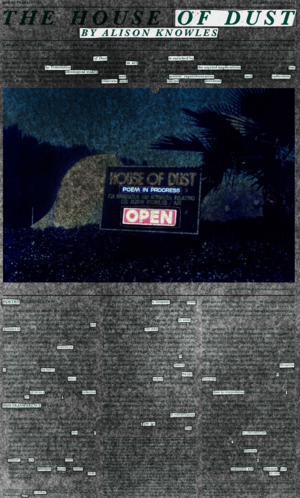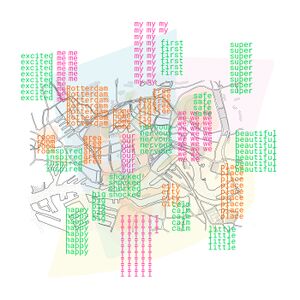Special Issue 16 Work
With our Special Issue 16 and prototyping classes, we aimed at combining programming with processing natural language. Thus, we started with Python (from scratch) and played with ways to process text. Each week we had to go through reads about Python and to learn to code step by step. At the same time, we also had reading sessions with Cristina and research, reading and writing with Steve.
Vernacular language processing methods
00. Mix of Sauces
Reader prototyping project developed in class by Kamo, Supisara & me. We tried the method of taking a complex text and simplifying by putting it in chat bubbles. Find out more here.
01. Blackout (poetry)
def Blackout poetry - when a page of text is completely blacked out (coloured over with permanent marker so that it is no longer visible) except for a selection of few words. When only these words are visible, a brand new story is created from the existing text.
Blackout (poetry) is an intervention in someone else's work to create new meanings, express new ideas, find new directions. It can also be a way to annotate and focus on the big picture. Or focus on particular elements and ideas on the written piece.
Example: I used this method as an experiment to annotate one of our reads. Blackout poem from the first page of the "House of dust" journal, see here. There are at least two ways to read the annotated result - 1 here and 2 here.
02. Repetition and new meanings
By printing a short sentence a hundred times, repeating itself, we can discover a new meaning. We can start from a different word every time and construct several meanings. Pretty simple, but fun to try. Example: Welcome to the World of Bees
03. Petition comments processing
Experimenting with my first steps in processing natural language with Python. For this exercise I took a petition tackling the housing crisis in the Netherlands and the comments of people who signed it. In order to get to know their stories, real problems and reasons for participation, I copied their comments in a pad and then ran a function to extract the adjectives - the words they used to describe the situation or their feelings. See the petition comments pad here and the pad with the extracted adjectives. Here is the processing code.
Challenges not solved: we see the adjectives out of context; you don't see when an adjective had also a negative "no/not" before it. How do you get what was the sense behind the adjective when filtering them like this? What can you do with this output?
04. Rejection as a self-care
Together with Miriam, we elaborated on the idea of looking at the rejection as a self-care mechanism. Here are our concept and brainstorming.
Final project: Annotation Compass
As part of our "Learning How To Walk While Catwalking" themed special issue, together with Kamo, Jian, Kim, Supi and Emma, we created and explored the "Annotation Compass": a tool for gathering situated impressions in order to create individual, vernacular and poetic readings of various inputs (such as space, image, text).
Rotterdam Impressions
My experiments with the Annotation Compass focused on our little group of strangers who became a group. During my research, I invited my classmates to reflect on their arrival in Rotterdam and share how they felt about some particular places that trigger stronger emotions or memories.
"We all arrived here from different places, backgrounds, (hi)stories and languages. As a group, we are building our relationships and exploring our personalities - a process that takes as long as it gets. Brought to this new place, we also explore it both individually and collectively. The city is our everyday environment - we pass by it to come to school, to go home, to do our grocery, to have a drink out (when we used to be allowed to), to visit each other. We spend some of these moments sometimes alone, sometimes with someone else. In this short moment of reflection, I would invite you to think of Rotterdam as your new destination. Look at the map and remember how you felt when you first arrived here. What places did you visit first? What places triggered some strong emotions in you? How do you feel about these places now? Would you like to share some with the group?"
The illustrated subjective maps represent the impressions of the first-year master students of Experimental Publishing at the Piet Zwart Institute. Their situated experiences trigger various ways to describe their new home: Rotterdam. They were invited to reflect on the way they remember some of the areas in the city and to describe how they feel about them. In words, in their own vernacular English - the common language that is not native to any one of them but the main language they communicate between each other. Afterwards, their descriptions were filtered by a Python function to extract the most common words they used whilst describing their perceptions of the selected areas on the map, divided in three main categories - adjectives, nouns and pronouns. The final outcome is this shortlist of the most common impressions of various places and illustrated maps as an artistic expression of the author.
Discover my showcase of the "Annotation Compass" here.
See my whole journey here.
More documentation of the process is collected here and here.
Research
What is vernacular language? Before, now, tomorrow. When was the first time anyone came up with the concept of vernacular? How can it be processed? What interventions can be done and why?
In the world of abstract, whilst trying to orientate myself, I am looking for familiar things and starting points. Drafts from my exploration are available here and here.
During the trimester, I was mainly struggling with understanding what is vernacular and in what context we would like to work with the term on our publication. We oftentimes went in various directions and did not focus on the language that much (e.g. somehow we worked on the topic of "rejection" for a few weeks). Thus, various deviations came up as part of the project - such as maps. They became the common ground for some of us to approach the subject and this is how (and why, I guess), we focused on working on the Annotation Compass.
Prototyping
Embracing on a journey to play with programming and create stuff whilst doing that.
First trimester:
- Functions Library (a collection of functions to have in handy)
- Week 01 - first steps in Phyton (XP 4, 5 & 6)
- Week 02 - processing language & more experiments (XP 7, NL 1)
- Week 03 - nltk, first baby steps to do our own functions (NL 2, XP8 hopefully...)
- Week 04 - XP, NL
- Weeks 05-06 - hello, corpora
- Week 07 - catching up with XP and counting
- Week 08 - using Python for processing input on etherpad
- Week 09 - using Python to create html file, enhance with css
- Week 10 - flask, forms, more experiments with rotterdam impressions idea
Reading, Writing and Research Methodologies
The classes with Steve were a new type of sessions for me: I have never done collective annotation before. In the beginning of the classes, he invited to us to look for the best ways to annotate texts and to really find the method that works for us - collectively and individually. Because the Etherpad was also another new tool to use, we started using it for everything - all of our notes and reflections. It took me quite some time to get used to these classes and to be able to take the best out of them. Therefore, for me, the first trimester was mainly to get acquainted with this new practice and to find my own annotation style.
Reads
[Orientation in a Big World: On the Necessity of Horizonless Perspectives by Patricia Reed] starting with such a difficult read was quite frustrating and scary. We read it over and over again, but I couldn't understand the text and got lost in it many times. Collectively annotated by Gersande, Emma and I.
[Queer Phenomenology by Sara Ahmed] reflections on what does it mean to be orientated and how our desires drive us in specific directions. My individual notes are here.
[The House of Dust by Alison Knowles] I experimented with the journal by using blackout poetry to annotate it. More about it here.
Creating a Reader
Prototyping a reader with Steve.
Reflection
My reflections on the process of creating our first Special Issue.


